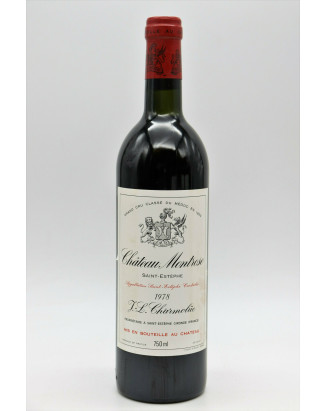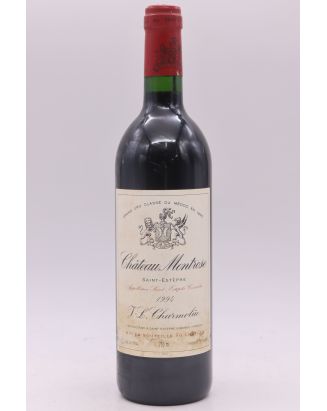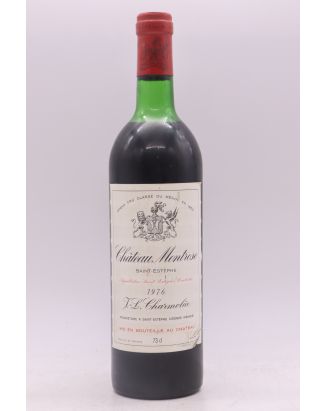












Château Montrose was officially established in 1815 when Théodore Dumoulin planted the first vines on the Lande d'Escargeon. However, the history of this site dates back much further. In 1778, Étienne Théodore Dumoulin purchased these then-virgin lands, sensing their exceptional potential. The estate was named "Montrose" in reference to the pink heather that once carpeted the hills.
After Dumoulin's death, the estate passed into the hands of Mathieu Dollfus in 1866. He greatly modernised the operation while respecting local viticultural traditions. Under the management of the Charmolüe family, from 1896 onwards, Château Montrose continued to prosper. In 2006, the estate was taken over by brothers Martin and Olivier Bouygues, who undertook modernisation works whilst preserving the estate's heritage and reputation.
Château Montrose stands out with exceptional vintages rated 100/100 by Robert Parker, including 2009, 2020, 1990 and 2022, which epitomise perfection. The 2016 vintage received an impressive 99+/100, while 1947, 2005 and 1921 were awarded 98/100, confirming the greatness of this Saint-Estèphe grand cru.
Château Montrose's vineyard spans 95 hectares in a single block on the left bank, a rare occurrence in Bordeaux, surrounding the château, cellars, and operational buildings. This unique feature allows for homogeneous and precise vineyard management, favouring optimal attention to each plot.
Château Montrose's lands benefit from a unique terroir, consisting of perfectly drained gravel crests, a precious asset for viticulture. The clay subsoil, rich in minerals, acts as a natural water reservoir, allowing the vines to draw from deep underground, even during periods of summer drought. Thanks to this exceptional terroir and proximity to the Gironde estuary, which regulates temperatures, the estate is protected from spring frosts and intense summer heat.
The grape varieties at Château Montrose are typically Médocain, with a predominance of Cabernet Sauvignon (60%), accompanied by Merlot (32%), Cabernet Franc (6%), and Petit Verdot (2%). This blend of grape varieties contributes to the complexity and depth of the wines, with each plot carefully adapted to a specific variety to optimise its expression.
Winemaking at Château Montrose is a meticulous process that respects the authenticity and quality of the fruit. The harvest is carried out manually, and the grapes are carefully sorted at several stages before reaching the vinification vats. The estate has 92 temperature-controlled stainless steel vats of various sizes, allowing for tailor-made plot-by-plot vinification.
The winemaking process aims to capture the essence of each micro-terroir. Each step, from fermentation to vatting, is carried out carefully to preserve the integrity of the fruit. Vatting lasts up to 25 days, with particular attention to the gentle extraction of tannins and aromas. The running off is carried out by batch to preserve the diversity of aromatic profiles for the final blend.
The wines are aged in French oak barrels, with a variable proportion of new wood depending on the cuvée. The Grand Vin, Château Montrose, benefits from 18 months of ageing in 60% new barrels, bringing structure, finesse, and ageing potential.
Château Montrose
Château Montrose is the estate's Grand Vin, a wine that lives up to its reputation. Produced mainly from Cabernet Sauvignon, it embodies the elegance and power of the great Saint-Estèphe wines. This wine is distinguished by its tannic structure, its complex bouquet of black fruits, liquorice, and cedar, and its exceptional ageing capacity. Some vintages, such as those from 1990, 2009, and 2010, have received the highest distinctions with perfect scores from international critics. Château Montrose represents approximately 35 to 40% of the estate's production.
La Dame de Montrose
La Dame de Montrose, the estate's second wine, was created in 1983 in tribute to Yvonne Charmolüe, former administrator of the estate. This wine, dominated by Merlot, is more accessible than the Grand Vin. It is supple, silky, and offers generous aromas of red fruits and sweet spices. With 12 months of ageing in barrels (30% new), La Dame de Montrose is distinguished by its refined style, more quickly appreciable in youth, while reflecting Montrose's unique terroir.
Tertio de Montrose
Tertio de Montrose is the estate's third wine, vinified with the same rigour as its elders. Produced from younger vines, it is aged for 12 months in barrels, 15% of which are new. This wine, formerly called Saint-Estèphe de Montrose, is particularly appreciated for its freshness and fruity character. Thanks to its immediate charm, it is often destined for restaurateurs and represents an ideal entry-level wine to discover the Montrose style.
The wines of Saint-Estèphe, a prestigious appellation of the Bordeaux vineyard, are distinguished by their elegance and longevity. Among the finest vintages are the years 1975, 1982, 1985, 1986, 1989 and 1990, which have impressed wine enthusiasts with their power and complexity. The following decades have not been outdone, with exceptional vintages such as 1995, 1996, 2000, 2003, 2005, 2008, 2009, 2010, 2012, and more recently 2014, 2015, 2016, 2017, 2018, 2019 and 2020. These years have confirmed Saint-Estèphe's ability to produce wines combining finesse and depth, emblematic of the Bordeaux terroir.
The Second Growths of 1855 constitute a prestigious category, grouping together iconic estates that often rival the First Growths in quality. Among them, discover Château Brane-Cantenac and Château Durfort-Vivens, both located in Margaux, as well as Château Lascombes, Château Rauzan-Ségla, and Château Rauzan-Gassies. In Saint-Julien, wine enthusiasts will appreciate the wines from Château Ducru-Beaucaillou, Château Léoville Las Cases, Château Gruaud Larose, and the famous Château Léoville Poyferré and Château Léoville Barton. Don't miss Château Cos d'Estournel and Château Montrose in Saint-Estèphe, as well as the essential Château Pichon Longueville Baron and Château Pichon Longueville Comtesse de Lalande in Pauillac.
Château Montrose, with its unique terroir, rich history, and exceptional wines, stands as one of the jewels of the Médoc. Whether through the Grand Vin, La Dame de Montrose, or Tertio de Montrose, each cuvée finely expresses the complexity and richness of the Saint-Estèphe soils. The estate's commitment to quality and innovation, while respecting traditions, continues to seduce wine lovers. For enthusiasts and curious alike, Château Montrose is an essential reference, offering wines that age admirably and transcend generations.